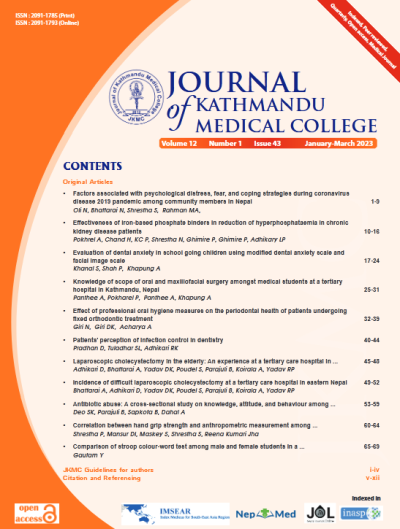Factors associated with psychological distress, fear, and coping strategies during coronavirus disease 2019 pandemic among community members in Nepal
DOI:
https://doi.org/10.3126/jkmc.v12i1.56686Keywords:
Community, Coping strategy, Coronavirus disease 2019, Fear, Psychological distressAbstract
Background: Coronavirus disease 2019 (COVID-19) pandemic had huge impact on social, psychological, and economic well-being of general community people in Nepal.
Objectives: To assess the extent of psychological distress, fear, and level of coping strategies among community members in Nepal.
Methods: A nationwide analytical cross-sectional study was conducted among Nepali residents aged >=18 years using an online structured questionnaire during 2020 December to 2021 January. Kessler Psychological Distress Scale (K10), Fear of COVID-19 scale (FCV-19S) and Brief Resilient Coping Scale (BRCS) were used in this study. Univariate and multivariate logistic regression analyses were conducted to adjust for potential confounders. Ethical clearance was obtained from institutional review committee of Kathmandu Medical College.
Results: Among 311 respondents, 167 (53.7%) were female. Median age (IQR) 31.3 (13) years with age range 18-69 years. Mean age was 31.4 ± 10.3 years. Being above 30 years old (AOR 3.8, 95% CI 2.13-6.84) were associated with higher levels of psychological distress. Being a female (AOR 0.55, CI 95% 0.30-0.99), moderately improved working situation due to change of employment (AOR 0.39, CI 95% 0.20-0.76), having little perceived distress due to change of employment status (AOR 0.52, 95% CI 0.27-0.97), having positive impact of COVID-19 on financial situation (AOR 0.28, 95% CI 0.13-0.61) were associated with lower levels of fear based on the FCV-19S scale.
Conclusions: This study identified individuals who were at higher risk of psychological distress, level of fear, and low coping strategies during COVID-19 pandemic in Nepal. These findings would assist in exploring the strategies to support mental health of vulnerable population during pandemic and post-pandemic periods.
Downloads
Downloads
Published
How to Cite
Issue
Section
License

This work is licensed under a Creative Commons Attribution-NonCommercial 4.0 International License.
Copyright © Journal of Kathmandu Medical College
The ideas and opinions expressed by authors or articles summarized, quoted, or published in full text in this journal represent only the opinions of the authors and do not necessarily reflect the official policy of Journal of Kathmandu Medical College or the institute with which the author(s) is/are affiliated, unless so specified.
Authors convey all copyright ownership, including any and all rights incidental thereto, exclusively to JKMC, in the event that such work is published by JKMC. JKMC shall own the work, including 1) copyright; 2) the right to grant permission to republish the article in whole or in part, with or without fee; 3) the right to produce preprints or reprints and translate into languages other than English for sale or free distribution; and 4) the right to republish the work in a collection of articles in any other mechanical or electronic format.




